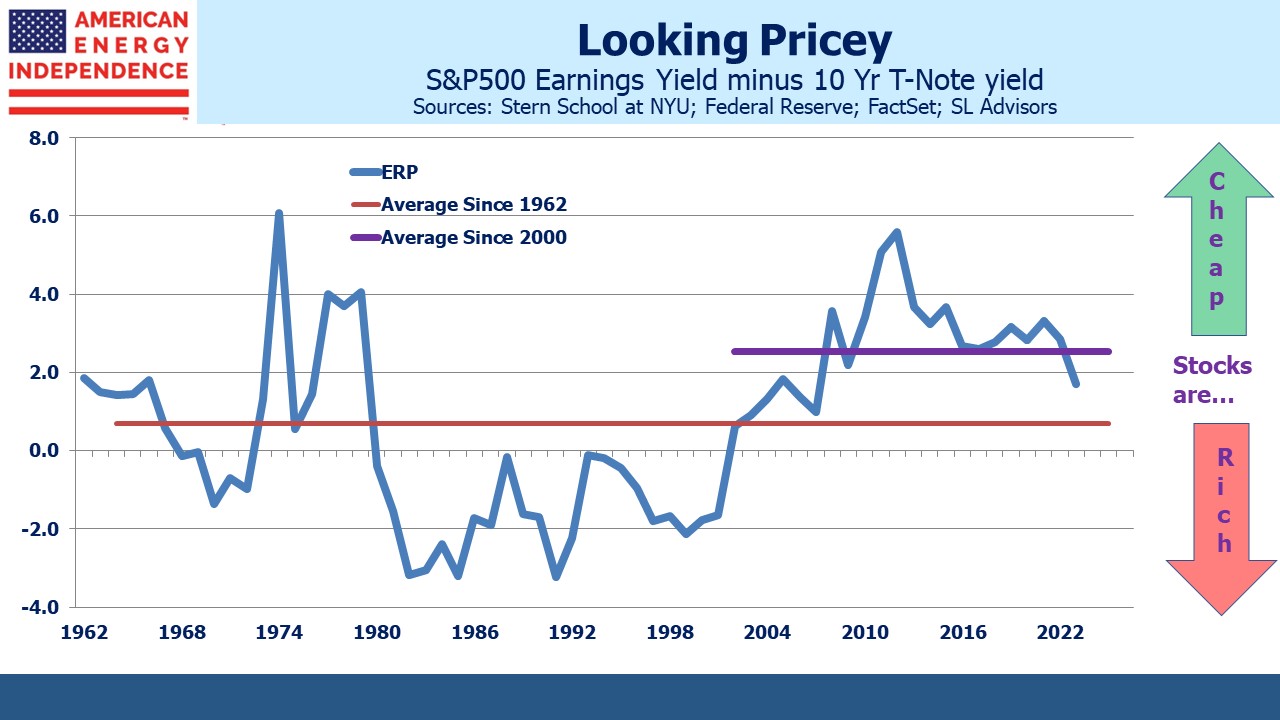Market Bows To FOMC Forecast
A couple of weeks ago stocks and bonds looked vulnerable to strong data (see Confronting Asymmetric Risks). Since then the narrative of impending recession has been punctured by employment, retail sales and inflation figures that all surprised to the upside. Valuations based on the Equity Risk Premium (ERP) were only moderate. Since then, stocks are slightly lower and ten year yields sharply higher.
The result is that the ERP shows stocks are the least attractively priced in over a decade. Earnings growth could offset this, except that analysts continue to revise them down. Bottom-up S&P500 2023 EPS of $224 is 10% lower than last summer and still trending down. It’s possible the strong jobs and spending figures will translate into upward revisions to earnings forecasts, but unlikely to be enough to change the overall picture.
Fed funds futures have also repriced sharply. The brief euphoria when Fed chair Jay Powell mentioned “disinflation” has been replaced by a growing acceptance that the FOMC’s predicted 4% YE 2024 Fed Funds rate might even be too low.
The ten-year treasury yield has risen around 0.30% since the end of January, but the correction in Fed Funds futures has been more severe. The likely path of monetary policy over the next couple of years has adjusted 0.50-0.60% higher in less than three weeks. In the past, large discrepancies between futures and the FOMC’s Summary of Economic Projections have been resolved in a way that confirms the Fed’s poor forecasting record (see Don’t Bet On A Return To 2% Inflation). For once the market has been forced to adjust.
Interestingly, some are beginning to make the case for dropping the 2% inflation target. Mohamed El-Erian argues that, “You need a higher stable inflation rate. Call it 3 to 4%.” Such views are in the minority and there’s no chance the Fed will alter their 2% target. So the risk for short term rates is that they go higher than currently priced in. However, a moderately higher inflation target is better for the US, if not the lost credibility the Fed would endure in getting there. How this plays out will impact investment returns for years. For now, inflation expectations remain well anchored in spite of the recent strong data.
Pipeline earnings continue to come in close to or better than expectations. Energy Transfer (ET) reported 4Q22 EBITDA 4% ahead of analysts’ expectations. On their ensuing earnings call they warned of a delay to their Lake Charles LNG project. Co-CEO Tom Long said that, “The LNG market along the Gulf Coast is currently extremely competitive.” There are several competing projects looking to sign up sufficient buyers to justify Final Investment Decision (FID) so they can start construction. Ultimately there’s little doubt that the US will grow its exports of natural gas, but long-term contracts of twenty years make a good marriage of buyer and seller critical.
An interesting response came when the Barclays analyst asked,”…if you could share your latest thoughts on a potential C-Corp currency.”
In 2014 Kinder Morgan acquired its MLP Kinder Morgan Partners (KMP), leading to a tax bill and reduced dividends for KMP investors. Other simplifications followed, and the MLP sector has never recovered its reputation. Energy Transfer gave up the GP/LP structure, but limited partnerships continue to provide weaker governance. It’s why MLPs are excluded from ESG indices – they score poorly on “G”.
It’s generally thought that the MLP conversions to c-corps have been done. Energy Transfer, Enterprise Products and Magellan Midstream have shown little inclination to adopt a corporate tax burden in exchange for a higher stock price. If you don’t intend to sell your MLP holding, the conversion makes little sense because future earnings and therefore distributions would be lowered by the 21% US corporate tax rate.
However, a business contemplating acquisitions using its equity securities as a currency might conclude the higher price granted a c-corp to be worthwhile. Hence Tom Long’s response was intriguing: “We do have a team that’s working on that. I guess the way I would tell you is that we are spending quite a bit of time in evaluating that. And we feel pretty good about probably 2023.”
This suggests a c-corp conversion is more likely than not and would reflect management’s desire to boost the stock price. ET’s stock price didn’t seem to react to a potential development that might be worth 5-10% to its price, and there were no follow-up questions. Alternatively, perhaps investors are wary of a conversion whose purpose must be to issue more equity so as to buy up assets. The ET management ethos can be characterized as prioritizing increased executive wealth over that of unitholders.
We have three funds that seek to profit from this environment:


